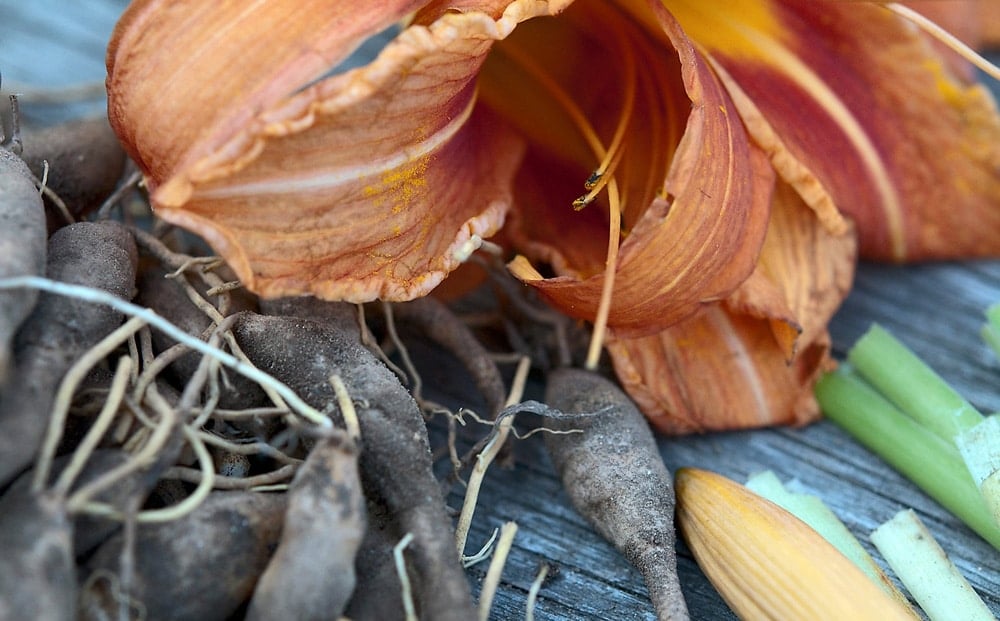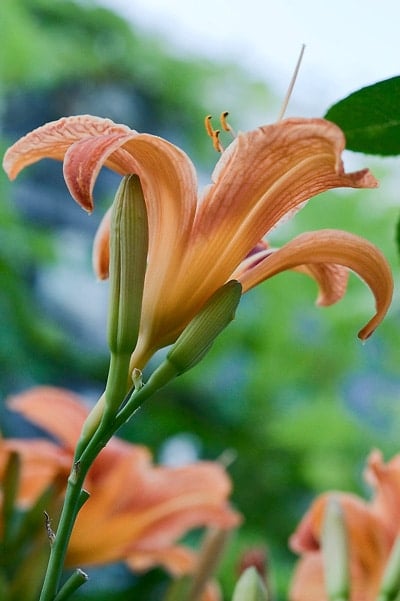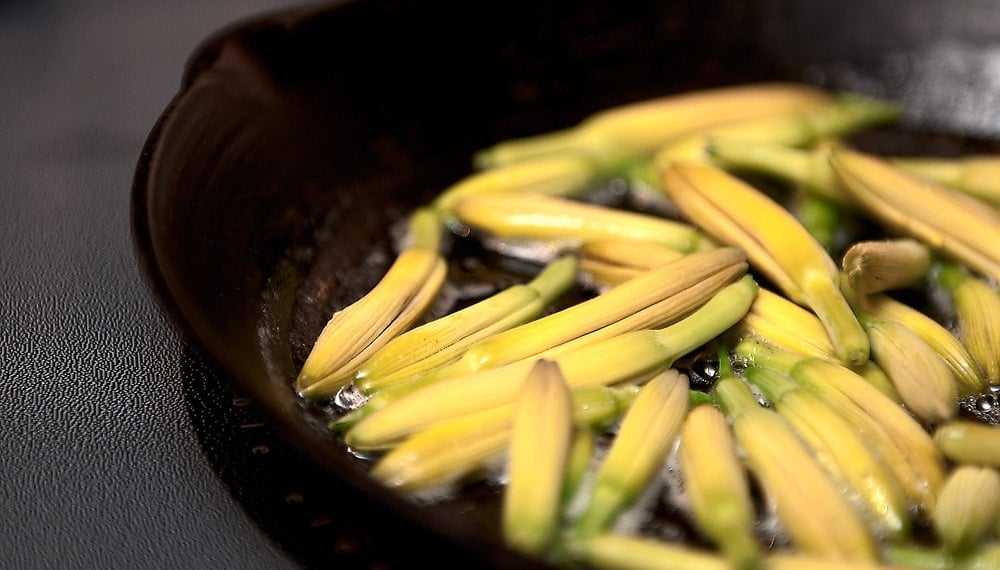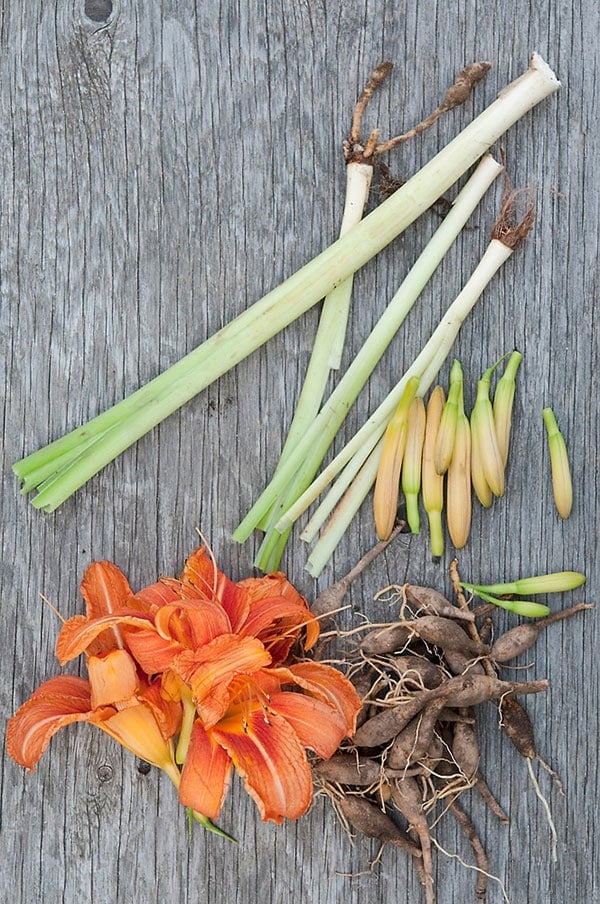As an Amazon Associate I earn from qualifying purchases.

Daylilies are not only edible, they are spectacular. After sampling the flowers, flower buds, young stalks and root tubers, I’ve come to the conclusion that they’re so tasty I may grow them as a food crop.
Let me start by saying that edible daylilies are the common daylily, Hemerocallis fulva, as well as its various Hemerocallis friends and relatives; there are thousands. What I am most definitely not talking about are bona fide lilies, like the Easter lily, which, if you are unfortunate enough to eat, you had better hope that the Resurrection is real…
I’d read long ago about the edibility of the common lily of my youth, which we incorrectly called tiger lilies because of their orange stripes. But this would have been in the 1980s, when edible flowers reached their trendy zenith. Nasturtium flowers all over the plate, anyone? Meh. My young self wrote off lilies as part of that prancy fad.
I first foraged for daylilies in Massachusetts, years ago. Any of you ever been to Cape Ann? Gloucester is covered in daylilies, and its ritzier neighbor Rockport has more daylilies than grass. Daylilies are the most common flower on the whole freaking island. So common my sister Lizz and my brother-in-law Mark have tons of them in their tiny yard.
So I am sorry to tell you there will be no stirring tale of high adventure as we stalked the semi-wild daylily. Nope. We just pulled a few plants and picked the flowers and buds from some others that were in the yard.

The drama with daylilies is all in the eating.
I first separated the plants into flowers, buds, and tubers — unlike true lilies, daylilies don’t have bulbs, they have little tubers instead that look like miniature fingerling potatoes. I then stripped the outer leaves from those plants that had not yet flowered, until I got to the white part.
Most sources say to saute the unopened flower buds with a little butter or oil and call it a day. Sounded like a plan, especially since I wanted to really taste the plant, not any supplemental seasonings. So in they went, just lily buds, butter and salt.

Delicious. Briefly cooked, the buds have a bit of knacken, a German expression meaning a “pop.” Yet the insides reminded me of squash blossoms. The taste? Green, with a whiff of radish and a dash of green bean. Honestly, I’d eat this as a side dish any day, any place. It needs nothing else.
We tried some of the stalks, but they were not as good. Texture like lemon grass, only without the wonderful lemon aroma. More like a bland, tough scallion. Certainly edible, and not terrible, but nothing like the buds.
The flowers are OK. They are more for color than flavor, and they are said to thicken soups the way okra or file powder do. The Chinese use them in hot-and-sour soup. Will have to try that more some other time.
That left the little tubers. First thing I noticed was that some looked exactly like fingerling potatoes, while others were pure white, like the inside of jicama. I ate a white one, and it tasted like jicama — only better. Like a raw sweet potato. Or rather a sweet, raw potato, not a yam.
I did the same treatment to the tubers: Butter, salt, saute. Only I added some black pepper this time. I like black pepper on my potatoes, so I reckoned I’d like this, too.
I was right. These are quite possibly the best tubers I’ve ever eaten. OK, that might not sound like ringing praise, but consider that I am including real potatoes in there and you get the picture.
Think really young fingerling potatoes, only with a sweetness to them. White ones are sweeter than the yellow ones. Yellow ones seem more substantial.
The only things daylilies have against them are allergies and size. A small number of people who eat daylily flowers get farty and nauseous afterwards; I hear “less than 5 percent” a lot, but I can’t verify it. Suffice to say you should eat only a little at first, the have at it.
The second “strike” against the lily, if it can be called one, is size: You’d need to uproot about five or six plants for one meal. But when you consider that hemerocallis fulva is considered a noxious weed in many of the 42 states it’s gone feral in, go ahead. Dig away.
Doing a little more research, I find that according to the USDA, the daylily has gone wild in every state except Alaska, Hawaii, Oklahoma, North Dakota, New Mexico, Arizona, Nevada, and, um, my own state of California. Sigh.
That said, you can’t swing a dead cat without seeing a planting of edible daylilies in a parking lot or person’s house, and they are so common in urban settings Charlotte Bringle Clarke writes about them in her Edible and Useful Plants of California.

Daylilies originally came from Asia, probably China. Chinese cooking uses them all the time, even in such starring dishes as moo shu pork and hot-and-sour soup. You will often see dried flowers called “golden needles.”
Euell Gibbons liked to batter-fry the buds, and lots of other old-timers “creamed” their daylily tubers, which sounds unappetizing. But beyond hippie forager types and the Chinese, I’ve found no other use of the daylily as food.
Pity. It is, as Jimmie Walker would say, Dy-No-Mite.





You might like Linda’s post on the subject:
https://www.playingwithfireandwater.com/foodplay/2009/07/daylily.html
We have them all over the place, though the deer will maul them if given a chance. I’m letting them spread so we’ll have enough to wantonly eat whenever we want.
Oh man, You make me homesick for the east coast. I used to nab daylilly buds from the NY Botanical Garden, not exactly wild, but a handful was so nice in a salad, cucumbery. I had half success with pickling them, but I’ll have to try it again some day.
I had no idea these were edible! I must try it!
Tamar: Figured as much. All things in their time, eh?
Carolina Rig: Dig, and ye will be rewarded…
Cecilia: I was labeled as weird, too. I got over it and ate crazy shit anyway. Sooner or later they’ll just chalk it up as a character flaw and move on. 😉
You made my heart sing when I read about your culinary adventures with hemerocallis. My Italian mother fed us the buds and tubers of the daylily when we were young, and our Illinois yard was overrun with the lilting orange blooms. When we were little kids, we thought it was fun to eat flowers–and other wild foraged foods–and did with abandon. That is, until neighborhood kiddos got wind of our gustatory inclinations and told us how weird we were. We caved and it wasn’t until I got older that I was able to appreciate forgotten food again. Thanks for your forays into true al fresco dining and discovery. Looking forward to your book.
I’ll second Tamar’s post…I’ve had some delicious stalks sauteed with lemon, butter, and pepper. Spring time only down here in NC. I’m digging for those tubers ASAP.
Don’t knock the stalks — you just got to them too late. When the daylilies first come up in the spring (as early as the end of March here on Cape Cod, and maybe just little later on Cape Ann), the stalks are a first-class vegetable. They’ve got the mild scallion flavor you describe, but they’re tender and snappy. Steamed, with a little butter and maybe a grind of pepper, they’re astonishingly good.
I just finished writing up two interesting posts: One of which was on… sugaring your edible flower blooms, while another was on: Hungry for tulips anyone? Therefore, you could only imagine how fascinated I was with your post. My backyard is swarming with Daylilies! You were a real delight to read and I certainly will follow you from now on. Great informational post along with gorgeous photos. Thank you.
Flavourful wishes,
Claudia
Jocelyn: Good idea. Will need to make hot-and-sour soup one of these days…
Deana: Oooh…. Bummer. Steal some from a neighbor then!
Allisen: Glad to have got this out in time then! Report back and tell me how you like them if you can.
Kevin: Just make sure they are daylilies, not Asiatics. Another common daylily is a Stella D’Oro, which is solid yellow.
Amy: Already faded?! Where do you live? I see them everywhere in California, and I’ve seen them at this time of year in other states I’ve lived.
Dawn: Try them tempura-fried. I bet it would be awesome.
Laura: I did not peel mine. Their skins are very thin, and you can literally wipe them off the white tubers.
Kindred: Pass that recipe along, will ya?
Nice! I recently found a recipe for pickling day lily buds in an Ortho Books Series from 1975. Now I’ll try them “in the raw” first.
Verrrry interesting. I’ll wait until my plants have multiplied some more and then may give this a shot.
Re: the tubers: I assume they need to be peeled. Do they peel easily? Knife or peeling tool?
I knew daylillies were edible, but i hadn’t gotten around to trying them yet. I’m glad I read your post though, because I would have just tried the flower portion, not the unopened buds. And I didn’t even know the tubers were edible. I love it when I discover new things and find more uses for items. Thanks for enlightening me. I’m looking forward to your book.
Dawn, that deepfried recipe sounds pretty amazing too. I don’t think you NEED to do that to make them taste good, but it certainly wouldn’t hurt. Thanks re the photos!
So glad you tried them first. I just wrote a short post about them last week and was wondering about how they tasted. We have a ton in our yard, but they’ve already faded for the year. Next year, they’ll be back, and with mo’ friends along for the ride. Butter, salt and pepper…who knew?
Excellent topic. I had some overgrown specimens in our yard when we moved in, and I moved them into my ‘forest garden’ border around my property upon hearing they were edible. I’ve popped a few flowers with a resulting ‘meh’, but have not tried the buds nor the tubers. Mine aren’t wild, clearly – are the common garden variety similar [or identical for that matter]?
Who knew daylilies were so delicious? I did! Well… sort of. I’ve never tried them, but put them on my “foraging list” after reading about them with my son in Jean Craighead George’s book “On the Far Side of the Mountain” (p.133). The main character, Sam, suggests moistening daylily buds in egg, rolling them in acorn flour, then frying.
Hank, I can’t decide which version sounds better, yours or Sam’s, so I’ll have to try them both. 🙂 Holly – great photos, as always.
I have a few daylilies in one corner of my vegetable garden. I only eat the tubers when I am thinning the plants. I use the one day old flowers in stir frys. That just means I share them with the bees. I like the color and the flavor. I keep a few flowering plants to bring in the bees. The spent flowers that are a little older reconstitute nicely in a little water.
Day lilies are one of my favorites,
This. is. awesome. I just inherited an overgrown community garden plot covered with these guys. They were going in the compost, but now they’ll go in my stomach. Thanks!
Oh Hank, if only I read this sooner. I can’t tell you how many bushels of those noxious tubers I have dumped into the compost… who knew they were edible.
I can’t wait to try them now!!!
The just-opened flowers are pretty fantastic in hot-pot situations: they look great on the platter with all the other fixins, and they retain their texture and crunch (not quite the right word, but precision of speech eludes me at this moment) even after bobbing around in the boiling broth for a while.
Thanks for the great post!